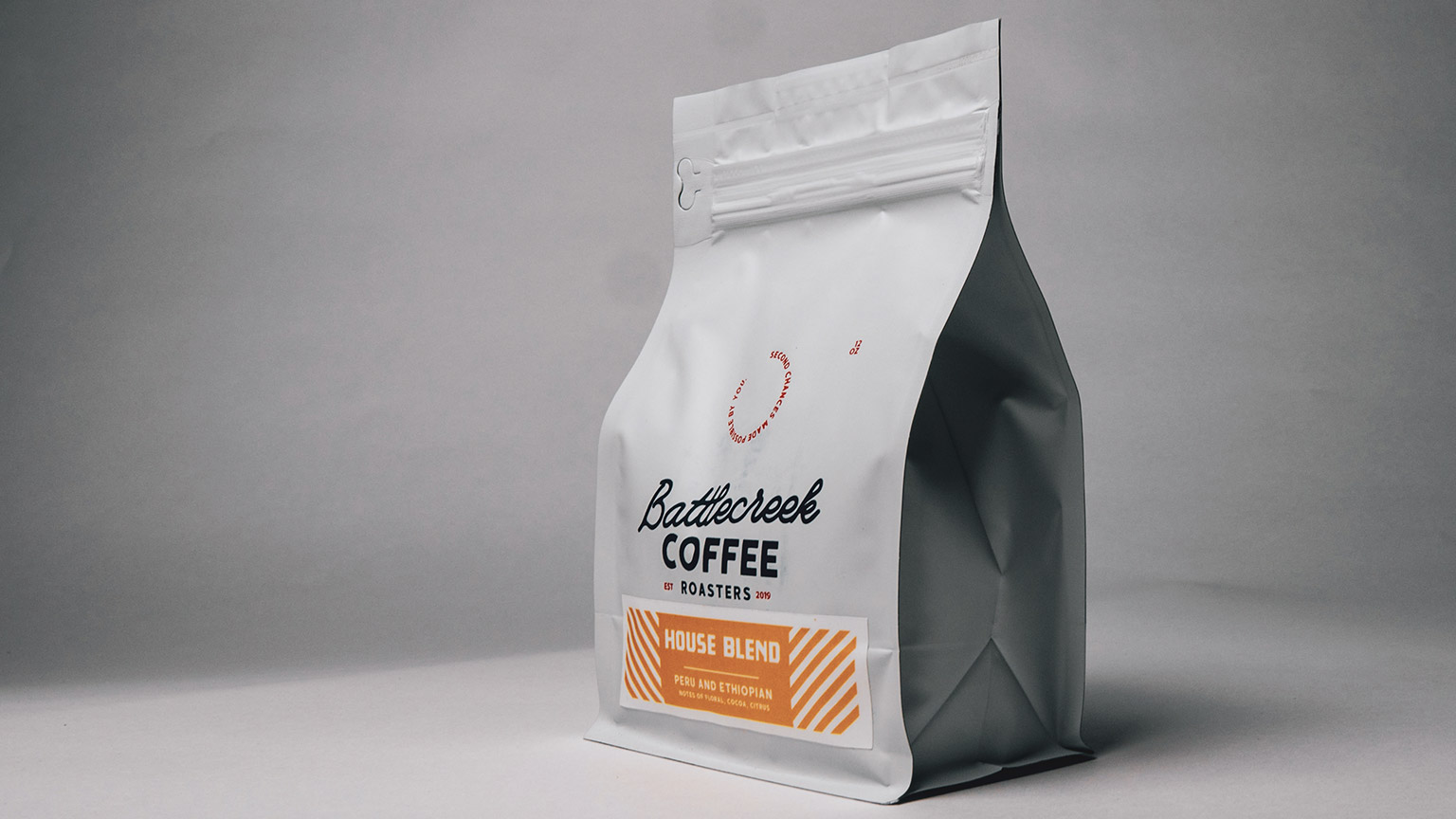In this topic we will cover the following:
- Digital mockup
- Dielines in packaging and print
- Finishing techniques – Embossing, debossing, foil blocking, laminates and varnishes
- Crafting techniques – Cutting, folding, gluing.
Wow! It looks so real...
A digital mockup is a photorealistic render of a design. Digital mockups allow you to test what works before committing time, money, and resources into production.
Digital mockups provide an accurate visual representation. You can easily assess whether the design is effective and what you envisioned. You can check detail such as logo visibility and text size. Mockups also provide an opportunity to experiment with various materials and designs cheaply.

Think about your stakeholders
Digital mockups look professional and give your design credibility. A digital mockup brings your design to life in 3D to a degree that a 2D sketch is unable to match. This makes communicating your ideas easier.
Digital mockups can even be used in place of early product photoshoots, saving time and money.
Mockups are produced before going to print. They allow you (and your stakeholders) to check the design, make corrections, and get sign off.
Create
Digital mockups are created in specialist software such as Adobe Illustrator and Adobe Dimension. Packaging can be designed in 3D, including product mockups and brand visualisations.
The following video provides an overview of the packaging design process and a case study. As you watch, think about what mocking up digitally allowed the creative team to explore.

A dieline is a design template needed to create the required layout (with artwork) to produce packaging and other printed documents. Watch the video for a quick introduction to dielines.
Dielines are used in the production of a wide variety of products including food and beverage packaging, brochures, pocket folders, and any product that requires custom shapes.
Anatomy of a dieline
A dieline displays the fold line, the cut line, and the bleed line.
Solid lines indicate cuts and dashed lines indicate folds. The colours used in the dieline should not be used elsewhere in the design. Different print companies may use different spot colours. Always check with your print company which colours they use.
- Fold line: indicated in red is where the package will be creased.
- Cut line: shown in black is where cuts are made.
- Bleed line: marked in green is the excess space beyond the cut line to prevent a white border from forming around the edge of the design.
Creating a dieline
Use computer software design tools such as Adobe Illustrator or Adobe InDesign to create dielines. If you are designing a dieline for a client, the client will likely have a tool of choice.
There are online resources with dieline templates. If using a template, ensure you make alterations to the dieline to make it your own. Always ensure the dieline is print ready.
- Template maker
- Design Packaging’s e-book, Packaging and Dielines
- Design Packaging’s second e-book, Packaging and Dielines 2: The Designer’s Book of Packaging Dielines
Dieline requirements
Dielines must be developed as vector art on computers with mathematically described lines. Define the dimensions – Length, width, and depth.
First create the dieline in Adobe Illustrator to know its exact size before placing it in an Adobe InDesign document for printing duplex. It is an excellent work-flow habit to form and an essential step that will save you time and money.
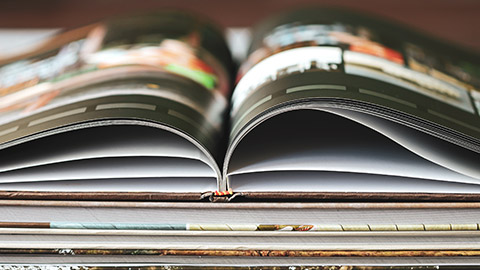
Finishing techniques are applied to a design after the substrate or paper stock has been printed on. Finishing techniques may be purely decorative such as adding texture with embossing or could be functional such as laminating to make the substrate more durable.
Starting at the finish
Finishing and binding are the last steps of the design and production process before the product is distributed. While physical finishing does not happen until late in the process, it is worth considering finishing techniques much earlier, including during idea, concept, and creative production.
What is possible?
Knowing what finishing techniques are possible provides direction and creative opportunities.
The finishing techniques you select will also impact decisions you make early on including the type of substrate used, layout of text and graphic elements, and choice of typography. A font may look totally different to how you envisioned when embossed, debossed, or foiled.
Keep in mind that finishing techniques will add to production time and cost. However, they can make a design standout from the competition and contribute to the overall look and feel of a design.
Embossing
A metal die holds an image which is stamped into the stock or substrate from below. This leaves an impression in the stock or substrate.
Designs are often slightly oversized, with extra space between letters and heavy lines. Intricate designs do not reproduce well. Thin stocks can hold more detail than thicker stocks. Coated stocks hold detail well but may crack. Uncoated stock is best for deep embossing (Ambrose and Harris 2016).
Creating texture
Riverland Orange and Lemon Rind is a body care range from Australian brand Maine Beach. Tactile finishes are created with an embossed pattern and embossed copper foil text and details. These finishes create packaging that is rich in textural detail and feels luxurious.
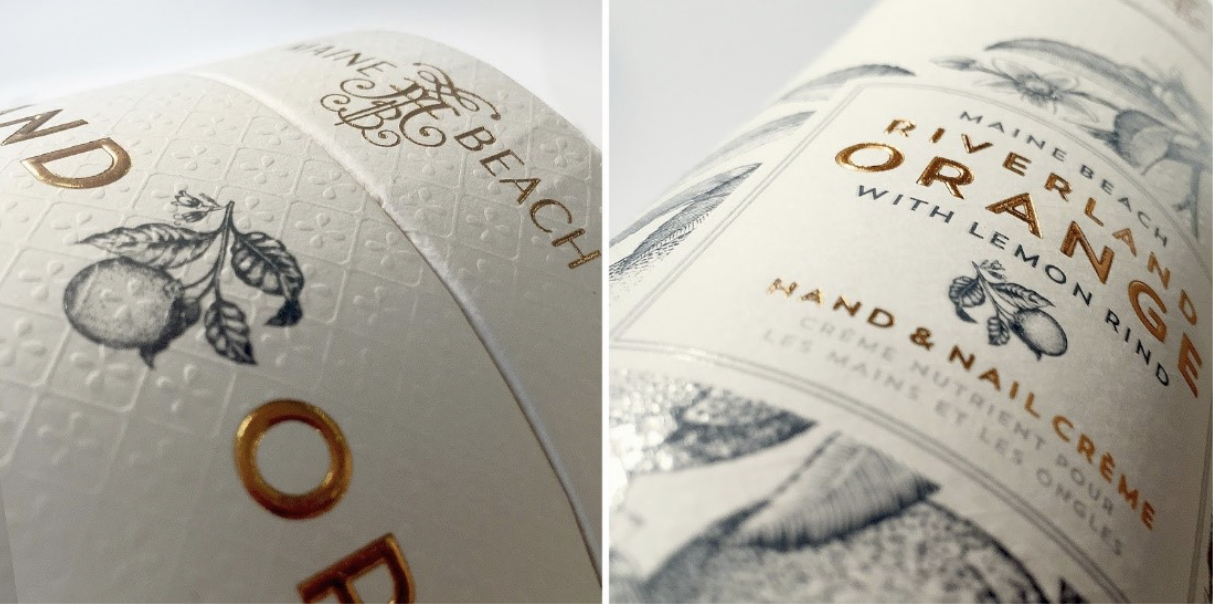
Debossing
Debossing stamps the substate from above creating an indentation.
As with embossing, the same considerations for thickness and detail of design should be applied. In contrast to the highlights made with a raised surface from embossing, debossing creates shadows of the indented surface (Ambrose and Harris 2016).
Shadows and pops
The packaging for Comvita’s UMF25+ Special Reserve Mānuka Honey was designed to draw on the concept of kaitiakitanga, guardianship of the sky, sea, and land.
Structurally, we wanted the box to unfold in layers, similar to walking through the forest. The treasured jar to be hidden in the depths and protected by the flora & fauna.Resonate
A mixture of debossing, embossing, foil, and raw, uncoated, textured stock, creates subtle layers, pops, and intrigue.
Comvita honey packaging designed by Resonate 2021, © Comvita Limited
Foil blocking
Foil blocking is when a coloured foil is applied to a substrate with a heated die. You may also hear this process being referred to as a foil stamp, foil emboss, heat stamp, or simply foiling.
Foil blocking adds a shiny finish to design elements. Foiling makes it possible to create metallic surfaces and colours, as well as extremely saturated finishes. It also changes the surface feeling and texture of the material.
24 carat gold
Creative agency Lander Project used 24 carat gold-embossed labels to mark Vinsanto, X – An Italian dessert wine that had been oak-barrel aged for ten years.
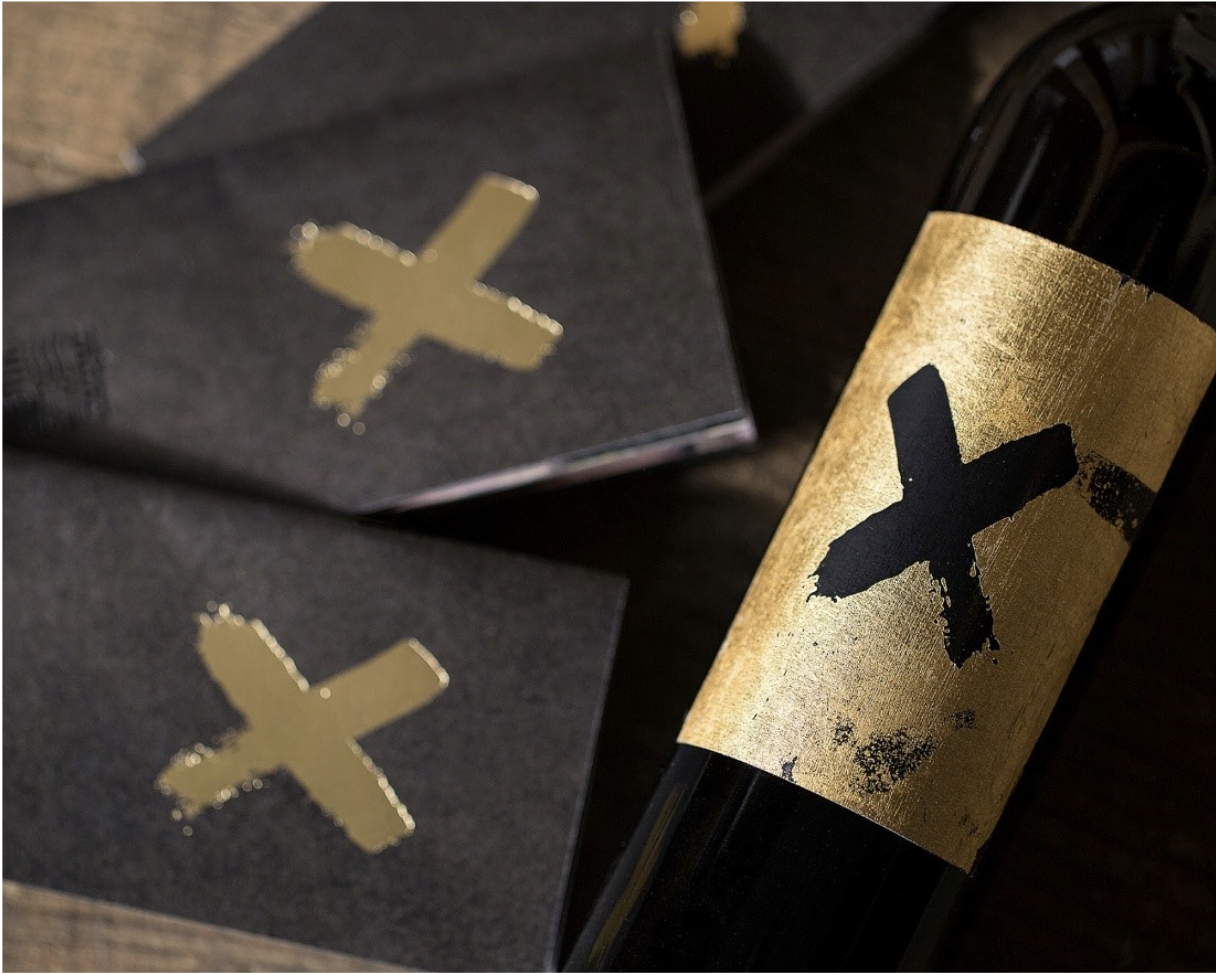
Only 100 bottles were produced and adorned with the gold labels. The labels were hand-crafted, and are more than just a bottle of wine – they are pieces of art meant to be treasured.
Laminates and varnishes
Embossing, debossing, and foil blocking are used mostly for aesthetic reasons. Laminates and varnishes on the other hand, have a functional element as well as changing the aesthetic.
Laminating and applying a varnish both result in the substrate having a glossy surface applied, however the techniques are slightly different.
Varnishing
Varnishing is the most common surface treatment. A colourless, liquid varnish is applied to the substrate via either a regular inking unit or a dedicated special unit for varnishing. The varnish can be applied to the whole design or only a part of it – This is called partial varnishing or a spot varnish.
Varnishing protects a design from smudging, against dirt, and wear. The extra protection means off-press processing can happen quicker. Varnishing can also enhance the visual design.
There are three kinds of varnish; oil-based, dispersion, and UV. Dispersion is water-based and is often used in food packaging as it is odour-free, can be done directly in an offset press, and produces a high gloss when printed wet-on-wet (same print run as the ink) (Johansson et al. 2011).
Dutch coffee brand, Zuivere Koffie, draws attention to its product with bold graphics. Thickening bubble spot UV varnish was applied to the graphic artwork lines to create maximum effort and a tactile effect.
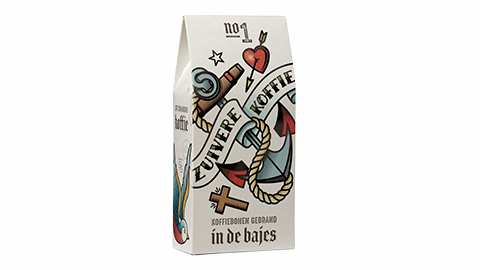
Laminating
A laminate is when a layer of plastic is heat-sealed onto the substrate. The effect is a smooth, impermeable finish providing protection from things like water, humidity, dirt, wear, and tear. Laminates can be matte, glossy, embossed, and textured.
The box for Sweet Virtues Chocolate Truffles is coated with a matt laminate for increased durability so the consumer keeps the box, after the chocolates have been eaten.
Initially, an uncoated, raw looking paper was to be used for the outer printed wrap, however, after testing, it was decided that this would not stand up to constant use... A matt laminate now protects the outer printed box wrap and brings out the rich, vibrant colours used on the packaging.Project Packaging, 2014.
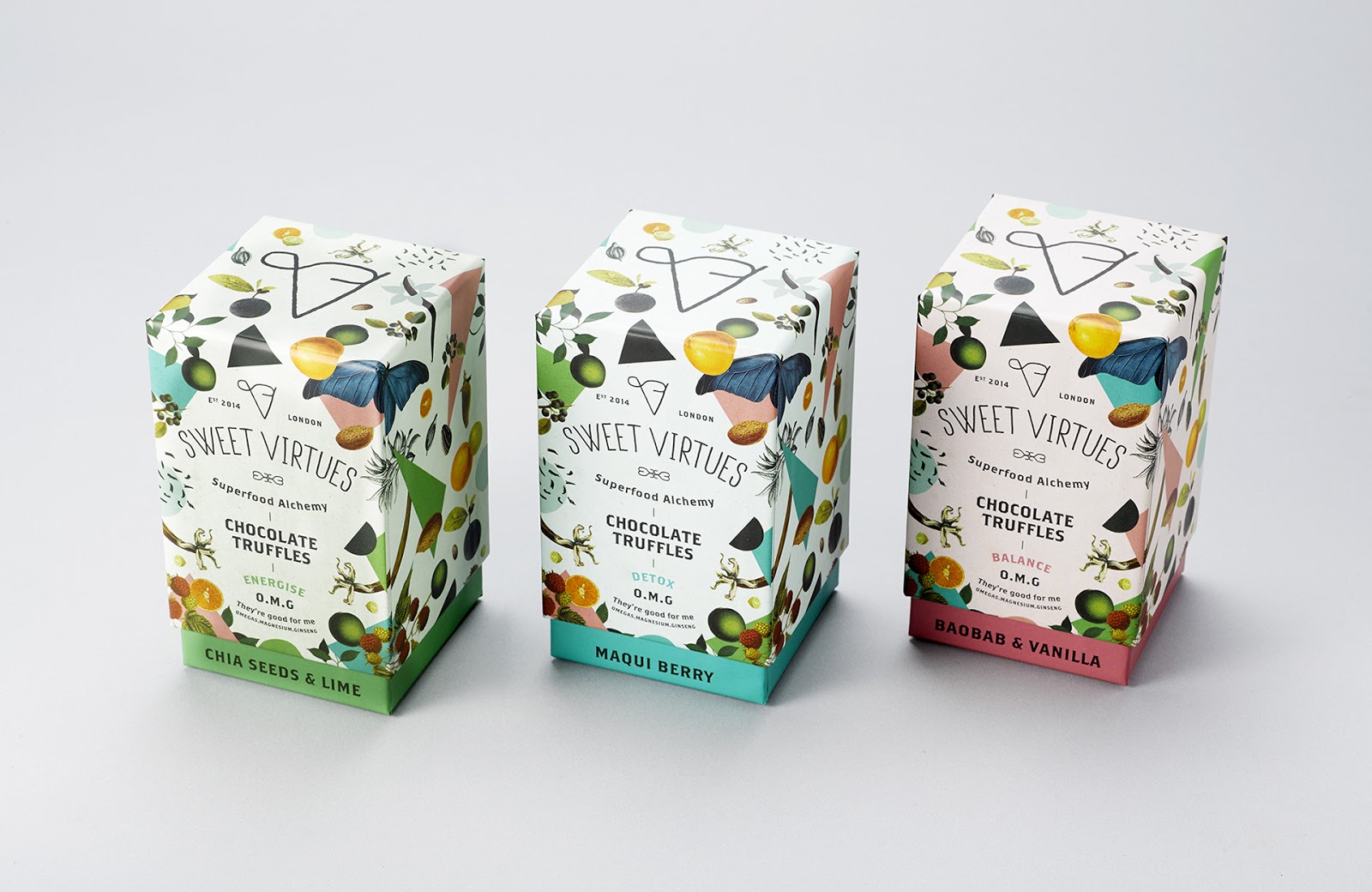
Scavenger hunt
Designers and packaging manufacturers use finishing and crafting techniques to make packages stand out on the supermarket shelves. What makes consumers pick up one product and ignore another?
Complete this activity at your local supermarket (for example Countdown, Four Square, New World, or Pak’n’Save). Let the manager know that you are conducting research for a student project. Ask if it is okay to photograph products.
If you cannot physically visit a supermarket or spend sufficient time in a supermarket, complete this activity via Countdown, New World, or Pak’n’Save’s online shopping websites.
Your task
For this task, you are asked to take photos of packaging designs that fit the specified criteria below. Along with your photos ensure that you:
- Record the brand and product name.
- Identify who you think is the target audience.
- Take a photo that shows the product and the competitor’s product.
- Document what you find on Canva or a similar tool.
(You are not required to purchase any products.)
Criteria
Find an example of a packaging design that:
- Has a large range of variations. Sketch a new variation.
- Has the most practical packaging. How is it more practical than its competitors on the shelf beside it?
- A product that uses gold foiling.
- A product that uses embossing.
- A product that uses laminates or varnishes.
- A product that uses debossing.
- A product that uses only two colours.
- A product that uses any other interesting finishing process. What process is used?
Share your research in the forum.
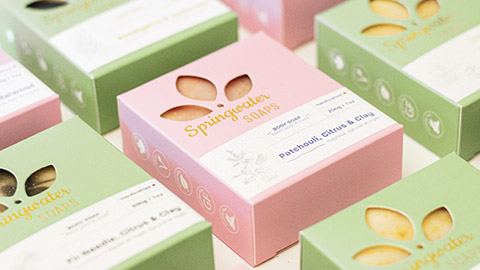
Cutting, folding, and gluing are the basis of turning your design into a 3D product.
Cutting
Cutting methods include die, laser, and kiss cutting.
Die cutting
Die cutting allows printed products to have shapes other than basic rectangles. A dieline is used to indicate where the cuts are made.
Die cuts require a shaped blade or “die” to be custom made. This means they are expensive, especially for small production runs, but they can be reused for reprints.
A die is created by placing a sharp, steel band on a wooden slab in the shape indicated by the dieline. The die is pressed against the material and cuts it to the specified shape.
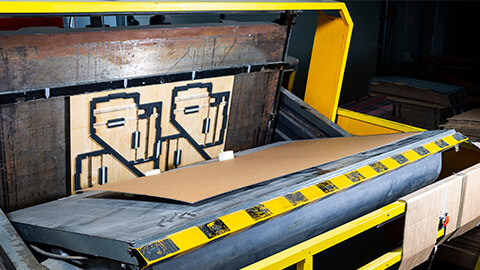
Scores and perforations are forms of die cutting where the substrate is scored or a dotted line punched, but the material is not fully cut. This is necessary for creating clean folds and is indicated on the dieline (Johansson et al. 2011).
Laser cutting
A laser is used to cut shapes into the substrate rather than a die. The cuts produced with laser cutting can be more intricate and cleaner than those produced with a steel die. However, the laser does burn the cut edge. Laser cutting is quicker to set up with fast turnarounds compared to die cutting (Ambrose and Harris 2016).

Kiss cutting
Kiss cutting is a form of die cutting used with self-adhesive substrates like stickers. The face stock is die cut but not the backing sheet. This makes it easy to remove the cut face stock (Ambrose and Harris 2016).
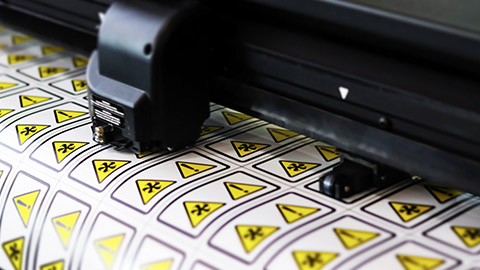
Folding
Folding turns a two-dimensional design into a 3D product. A flat piece of card becomes a 3D box.
Folds are indicated as dotted or dashed lines on the dieline. The substrate must be scored or perforated during the cutting process before it can be folded. Perforation and scoring ensure accurate, consistent, clean, and easy folding (Conover 2011).
Valley or mountain?
The majority of folding techniques use a basic valley or mountain fold to create peaks and troughs.
- Valley fold – The central crease is at the bottom with panels rising upwards to form the side.
- Mountain fold – The central crease is at the top with panels falling downwards (Ambrose and Harris 2016).
Gluing
Gluing is the process of using adhesives to join parts of your packaging to each other.
Gluing makes packaging functional but can also provide creative opportunities to create unique packaging designs. When selecting adhesives, it is important to consider safety, toxicity, and ease (or lack of ease) of opening.
Adhesives
Common types of adhesives include;
| Type of adhesive | Description and use |
|---|---|
| Pressure sensitive adhesives (PSAs). | PSAs bind materials together with contact and physical pressure. It is a permanent tacky bond and separation is easy. It is a popular choice for food packaging labels and can be applied to plastic, paper, metal, glass, and wood. |
| Fugitive glue (also known as “gummy glue” or “credit card glue”). | This is a temporary bond and often used in marketing applications where you do not want to damage the material. Bank cards stuck to a letter or product samples stuck to a magazine are examples of fugitive glue. |
| Ethylene vinyl acetate copolymer (EVAs) adhesives. | These are applied using a commercial hot melt gun. EVAs set fast, are functional, and have a long shelf life. They are common in the paper and packaging industry. |
| Metallocene hot melt adhesives. | These are also applied using a hot melt gun. Unlike EVAs there is little to no odour with metallocene. Metallocene is popular for usage in food packaging and cardboard boxes. |
The right glue for the job
It is essential that you select appropriate adhesives for food packaging to ensure product safety and quality. Remember that any material that may come into contact with food must be non-toxic.
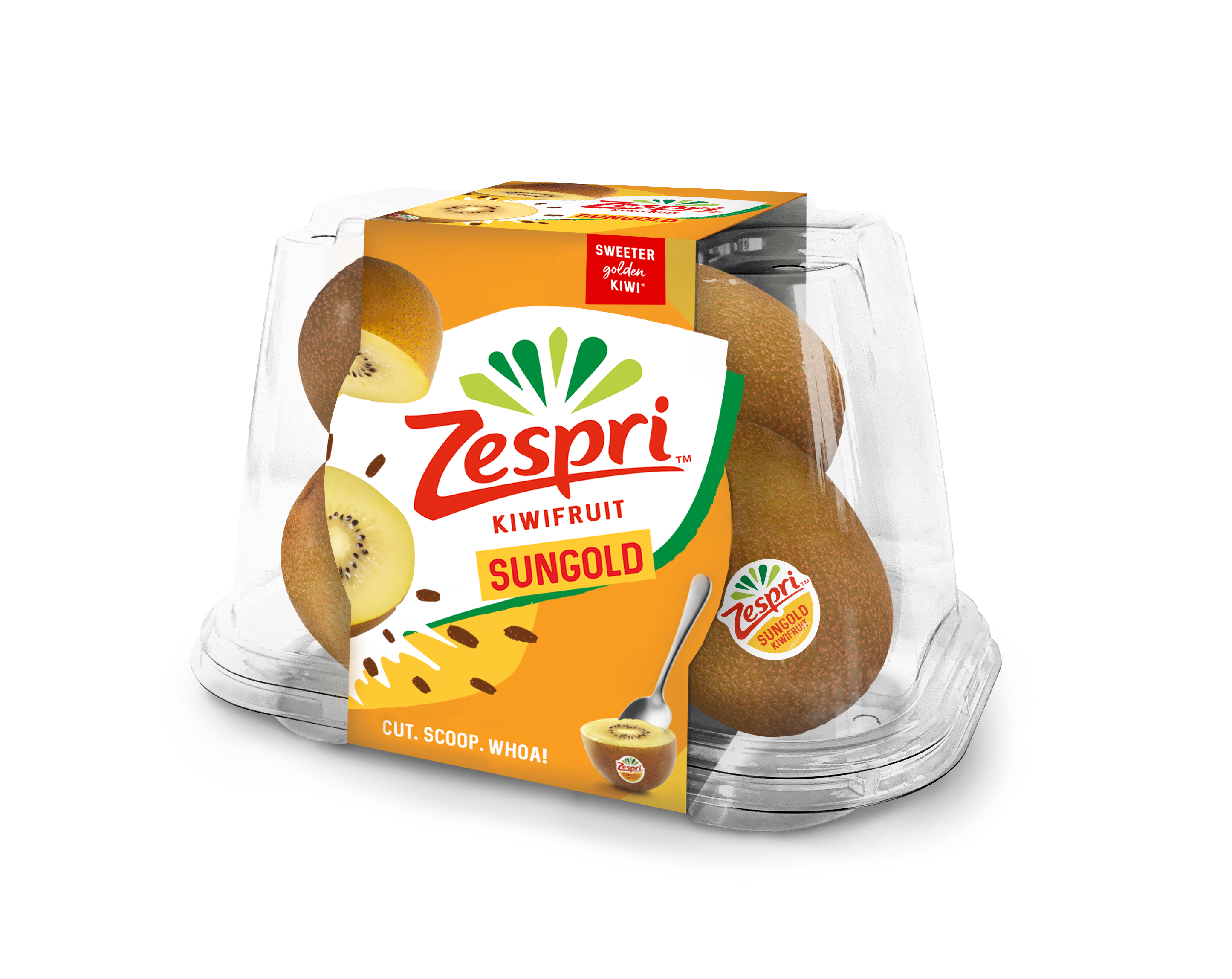
Solvent-based adhesives must be entirely dried after application and before use, so they do not impact the smell and taste of the food. If selecting a solvent-based adhesive, account for drying time in production timelines.
From a practical point-of-view, consider ease of unwrapping. Think about the rage and frustration you have felt as a consumer trying to get into a particularly over-sealed packaged.
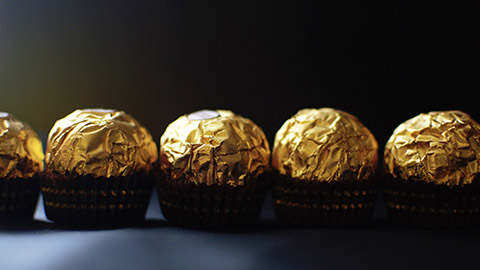
Surfaces like high-gloss paper, wax, and metallized PET are very difficult to bond. Packaging manufacturers will be able to advise the best adhesive to use for what you are trying to achieve (Heigl 2018).
Digital mockups are rendered three-dimensional illustrations of a design. They help bring your vision to life. Digital mockups can be used for stakeholder sign-off, and instead of expensive product shots in marketing material.
A dieline is a template showing the required layout of a design. Lines communicate where to fold, cut, and bleed the artwork to. Create dielines in vector format.
Consider the variety of finishing techniques available to add interest and functionality to a design. Popular finishing techniques include embossing, debossing, foil blocking, laminates, and varnishes.
Crafting techniques turn your vision into reality with cutting, folding, and gluing. We looked at three types of cutting – die, laser, and kiss, and considered the different types of adhesives available.
